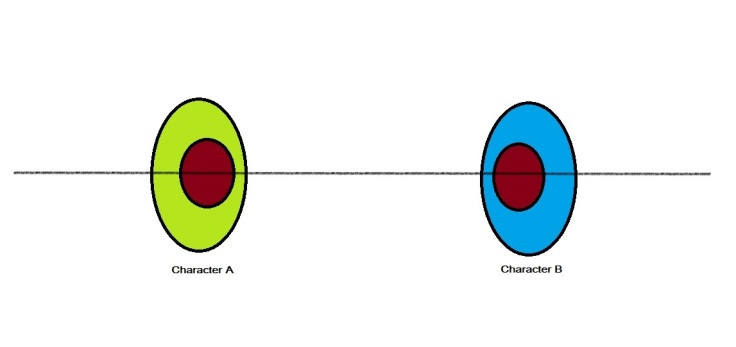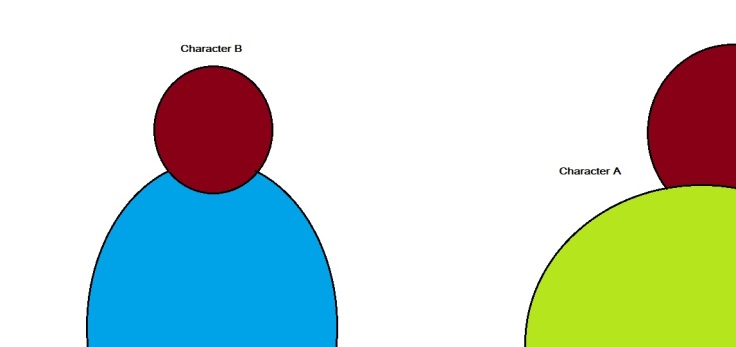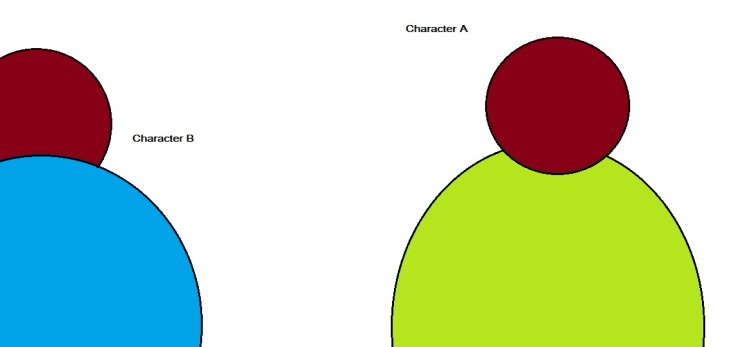Editing is arguably the most powerful tool of video. It creates movement, and can shift the meaning one way of another. With editing, you can control the pace of the scene being edited. For instance, in a fight scene you would want to edit in a way that would correspond to the fast-paced action going on, using quicker shots and a variety of different angles. Alternatively, a scene of a funeral or even a wedding, you would want to edit in a way to create a slow, peaceful atmosphere created by longer shots and maybe not as many different angles.
With that in mind, there are rules that you would generally abide by with editing. These rules establish continuity in the film so that the viewer doesn’t get confused and understands what they are seeing. One of these rules is known as the 180 degree rule. When shooting a conversation between 2 or more people, for example, the rule requires you to picture an imaginary line down the center of the two people (see image). 
When you are recording the scene, you must make sure that your camera stays on one side of the line without crossing, throughout the conversation. Eg: If you place your camera on the left side of character A and point towards character B, character B would be on the left side of the screen, and character A’s shoulder would be on the right.

To cut to character B, you would have to place the camera on the right side of character B in order to keep the continuity. The following shot would show character A on the left side, and character B on the right side.

Filming and editing this way ensures smooth continuity when viewing. However, if you wanted to create a chaotic atmosphere then you might choose to cross the 180 degree line.
Another rule to keep in mind is something more subtle. It is called the 30 degree rule and describes how a camera must move at least 30 degrees from it’s first shot before shooting the same subject, For example; imagine a scene of 3 people sitting at a table, one (A) is sitting across from the other two (B and C). In one shot, you have a close up of one of C showing their emotion; perhaps they are sad. Next, you might want to show a medium shot of both B and C to suggest that C is bottling their emotions. To do that, you would position the camera in a different angle that is greater than 30 degrees from the first shot. Alternatively, you could cut to a shot of A sitting by themself.
Continuity is extremely important in editing as it maintains the illusion of a new reality that film creates. As a director/producer, you want the viewer to become immersed in the film as they watch it so breaking that continuity via editing, angles, etc can break the illusion unless done a particular way. For example; typically the plot of a film would be shown in chronological order, or at least in an order that makes sense. You know the characters and their origins, and you go on a journey with them and get to the conclusion. In Christopher Nolan’s Memento we see quite a different plot.
Nolan reversed the order of the events and created a plot that almost mimics symptoms of someone suffering with memory issues, as our main character (Leonard) does. This unique technique is a great way to ensure that the audience relates more with Leonard as a main character and is ‘seeing’ through their eyes, reinforcing the idea of this being their story. As well as experiencing his frustration with each new scene (we are faced with a completely new location and have no idea what is going on), we are also able to feel sympathy for him as he learn that his wife was murdered and that he is seeking vengeance. Although we don’t necessarily have the ability to experience that first-hand, we can gain an understanding through the Leonard’s motives and how they deal with ‘re-remembering’ each time the scene ‘refreshes’. Surprisingly enough, the plot still works well in Memento and the audience is still able to piece together the story at the same pace as the main character.
The use of a second story happening between scenes is an effective tool to ‘break up’ the plot even more, as it’s often said that you remember things better when you take a step back from whatever you are trying to remember. In this instance, we have another man tell a story about his own difficulties with his memory and them resulting in his wife falling into a coma. This story, and the character, are equally important to the main story because this man has the same dilemma as Leonard. In his story, his diabetic wife was convinced that he was faking his memory troubles and so tested out her idea by having him inject her multiple times with insulin (he injects her, and she rewinds her clock back 15 or so minutes so it will remind him again). This deduced that he was not faking his illness because he was still failing to remember when he had last injected her and so he would continue to inject her again each time she set her clock back. Looking at this in another light, we could compare the two stories and even question as to whether the man in the secondary story is Leonard himself, as other characters in the story suggest. However, this is left to interpretation at the end of the film.
As well as using editing to ‘entice’ the audience into this new world created by a film, editing is used to establish meaning and create a certain atmosphere. Editing gives a movie pace, rhythm, and is done to keep the audience interested. As a rule of thumb, shots are rarely longer than roughly 5 seconds long depending on the genre and the kind of atmosphere you are trying to create. You can see the difference it creates by watching a horror film and a rom-com both on mute. You should see that horror genres will generally use either long shots or very short shots to constantly vary the rhythm to keep the viewer on the edge of their seats. Rom-coms tend to focus on realism with maybe some exaggeration in some shorts, so the variation of shot length wouldn’t be as variable as with horror and the rhythm of the film would be fairly consistent. All in all, editing is an extremely important factor to consider when either watching or editing a film because it can completely change the message you are trying to portray.

Leave a comment